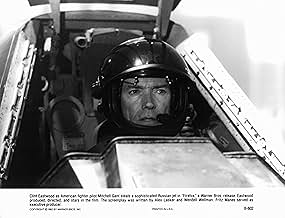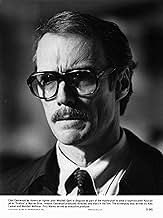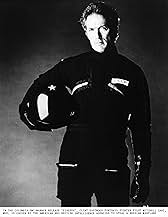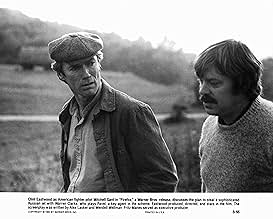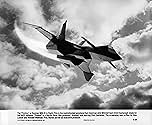CALIFICACIÓN DE IMDb
5.9/10
31 k
TU CALIFICACIÓN
Un piloto viaja a la Unión Soviética en una misión para robar un prototipo de caza a reacción que puede controlarse con un dispositivo neuralink.Un piloto viaja a la Unión Soviética en una misión para robar un prototipo de caza a reacción que puede controlarse con un dispositivo neuralink.Un piloto viaja a la Unión Soviética en una misión para robar un prototipo de caza a reacción que puede controlarse con un dispositivo neuralink.
- Dirección
- Guionistas
- Elenco
Klaus Löwitsch
- General Vladimirov
- (as Klaus Lowitsch)
- Dirección
- Guionistas
- Todo el elenco y el equipo
- Producción, taquilla y más en IMDbPro
Opiniones destacadas
... and by my count this line was spoken at least seven times here.
This is a cold war thriller from Clint Eastwood about a Vietnam vet fighter pilot sent undercover and across the iron curtain to steal a new Soviet super-plane. The first two-thirds of the film are a treat, with a lot of tense scenes of Clint and his sympathetic Russian contacts narrowly escaping capture. The last section is where the film loses steam, with a lot of repetitious, dated fx shots of the jet in action.
Warren Clarke is memorable as Clint's chief contact. Also featured are Freddie Jones, Ronald Lacey, Nigel Hawthorne, and Kenneth Colley. As you may have noticed, there are no women listed; this is the rare film with no substantial female presence at all. The real star, though, other than Clint, is the fictional MiG31 "Firefox" fighter jet, invisible to radar, capable of Mach 6 speeds as well as full nuclear armament. The film also borders on science fiction with the jet's thought-controlled weapon systems.
It is a 50/50 proposition as to whether you will like this one. For me it was fun to see Eastwood stretch his directorial skills in a different direction, and even more fun if you actually remember the cold war...or were even alive during the cold war for that matter.
This is a cold war thriller from Clint Eastwood about a Vietnam vet fighter pilot sent undercover and across the iron curtain to steal a new Soviet super-plane. The first two-thirds of the film are a treat, with a lot of tense scenes of Clint and his sympathetic Russian contacts narrowly escaping capture. The last section is where the film loses steam, with a lot of repetitious, dated fx shots of the jet in action.
Warren Clarke is memorable as Clint's chief contact. Also featured are Freddie Jones, Ronald Lacey, Nigel Hawthorne, and Kenneth Colley. As you may have noticed, there are no women listed; this is the rare film with no substantial female presence at all. The real star, though, other than Clint, is the fictional MiG31 "Firefox" fighter jet, invisible to radar, capable of Mach 6 speeds as well as full nuclear armament. The film also borders on science fiction with the jet's thought-controlled weapon systems.
It is a 50/50 proposition as to whether you will like this one. For me it was fun to see Eastwood stretch his directorial skills in a different direction, and even more fun if you actually remember the cold war...or were even alive during the cold war for that matter.
I saw this film when it originally came out in the theaters...well over 30 years ago. I'd enjoyed it, but times have changed, I have changed and technology has changed...so do I still think it's a decent movie? Well, surprisingly, yes...it still is pretty good.
The film is a real change of pace for Clint Eastwood. In this one, he plays a Vietnam War fighter pilot who is called out of reserves to help his country. They need an excellent pilot who can think in Russian to go into the USSR for a covert operation....to steal the Firefox fighter jet!! Why is it that important? Well, because they plane can apparently do about mach 6 AND it has a new neural interface...and it's much more advanced than American fighters.
Much of the film consists of the mission getting into the Soviet Union and then to the plane. To me, this was the most interesting part. Then, the final third or so of the film is flying the plane home...and avoiding all the missiles and the other Firefox fighter. This was amazingly made for 1982 but does look a bit dated today. You can't blame anyone for this...CGI technology just has improved tremendously since then. Overall, it's an exciting film and one that is far deeper and more interesting than a standard Eastwood shoot 'em up picture. Worth seeing.
By the way, although the film is mostly extremely well made, in the first of many (too many) flashback scenes, Eastwood's Phantom II jet turns into a Thunderchief fighter-bomber. This was a pretty sloppy use of stock footage.
The film is a real change of pace for Clint Eastwood. In this one, he plays a Vietnam War fighter pilot who is called out of reserves to help his country. They need an excellent pilot who can think in Russian to go into the USSR for a covert operation....to steal the Firefox fighter jet!! Why is it that important? Well, because they plane can apparently do about mach 6 AND it has a new neural interface...and it's much more advanced than American fighters.
Much of the film consists of the mission getting into the Soviet Union and then to the plane. To me, this was the most interesting part. Then, the final third or so of the film is flying the plane home...and avoiding all the missiles and the other Firefox fighter. This was amazingly made for 1982 but does look a bit dated today. You can't blame anyone for this...CGI technology just has improved tremendously since then. Overall, it's an exciting film and one that is far deeper and more interesting than a standard Eastwood shoot 'em up picture. Worth seeing.
By the way, although the film is mostly extremely well made, in the first of many (too many) flashback scenes, Eastwood's Phantom II jet turns into a Thunderchief fighter-bomber. This was a pretty sloppy use of stock footage.
Major Mitchell Gant an ex-Vietnam pilot who suffers from mentally scarred flashbacks and lives a life in solitary in the woods. He's asked back onto a mission, which involves sneaking into the USSR in many disguises. So that he can steal the Russia's new high-tech MIG-31 fighter plane called the "Firefox", which its weaponry works on mind control. Since his America's best pilot, naturally his their first choice to get the plane and fly it back to western soil.
I read a lot complaints against Eastwood's pacing being quite sluggish and can't help but agree. Although the final half of the film might get all the applause with its visual effects and fast-paced action thrills. But actually, I got more out of the atmospherically brooding old hat spy set-up involving Eastwood's character travelling around Vienna (masquerading very effectively as Moscow) to get to the MIG-31. After getting to the jet, it simply falls into the unremarkable bracket and the visual gimmicks come off junky looking and lack any real spark despite the rapid build-up. When it comes to the end, it feels sudden and unfulfilling. Eastwood is pretty dry, but convincing nonetheless as Major Mitchell Gant (since he can get along alone by his magnetic screen presence) and he tackles the director's chair with sharply tight, but practically no-frills direction. The pacing throughout does seem to flounder, but Eastwood creates some moody scenes with gloomy lighting (plenty of nocturnal shots) and Bruce Surtees' burnished photography is splendidly framed to achieve an atmospheric air of growing paranoia. Maurice Jarre's vividly classy music score is titillatingly on the spot. Eastwood deliberately soaks up the bleakly audacious cold war story (adapted off Craig Thomas' 1977 novel) with an array of twists, alienation and minor suspense chipped out of Alex Lasker's hauntingly calculated, but choppy screenplay. Two weak points though, would be there's not much focus and some coincidences are hard to digest. Why I say minor in the tension, is because the suspense doesn't last real long and by being overlong it becomes too relaxed in its own high-strung set-up. The productive script is highly talkative and filled with political jargon, but settles in with some warm moments to share a bit light on the characters. The supporting cast are all capably solid with the likes of Freddie Jones, David Huffman, Warren Clarke, Kenneth Colley and Stefan Schnabel. The glazed up special effects by John Dykstra (who won an Oscar for his work on "Star Wars (1977)") might be mesmerizing and refreshing, but they are far from impressive with one or two arresting sequences executed in between many clumsy takes.
"Firefox" is nothing particularly exciting and far from a success, but I found it strangely captivating and a handsome looking feature. The idea just doesn't entirely translate on this occasion.
I read a lot complaints against Eastwood's pacing being quite sluggish and can't help but agree. Although the final half of the film might get all the applause with its visual effects and fast-paced action thrills. But actually, I got more out of the atmospherically brooding old hat spy set-up involving Eastwood's character travelling around Vienna (masquerading very effectively as Moscow) to get to the MIG-31. After getting to the jet, it simply falls into the unremarkable bracket and the visual gimmicks come off junky looking and lack any real spark despite the rapid build-up. When it comes to the end, it feels sudden and unfulfilling. Eastwood is pretty dry, but convincing nonetheless as Major Mitchell Gant (since he can get along alone by his magnetic screen presence) and he tackles the director's chair with sharply tight, but practically no-frills direction. The pacing throughout does seem to flounder, but Eastwood creates some moody scenes with gloomy lighting (plenty of nocturnal shots) and Bruce Surtees' burnished photography is splendidly framed to achieve an atmospheric air of growing paranoia. Maurice Jarre's vividly classy music score is titillatingly on the spot. Eastwood deliberately soaks up the bleakly audacious cold war story (adapted off Craig Thomas' 1977 novel) with an array of twists, alienation and minor suspense chipped out of Alex Lasker's hauntingly calculated, but choppy screenplay. Two weak points though, would be there's not much focus and some coincidences are hard to digest. Why I say minor in the tension, is because the suspense doesn't last real long and by being overlong it becomes too relaxed in its own high-strung set-up. The productive script is highly talkative and filled with political jargon, but settles in with some warm moments to share a bit light on the characters. The supporting cast are all capably solid with the likes of Freddie Jones, David Huffman, Warren Clarke, Kenneth Colley and Stefan Schnabel. The glazed up special effects by John Dykstra (who won an Oscar for his work on "Star Wars (1977)") might be mesmerizing and refreshing, but they are far from impressive with one or two arresting sequences executed in between many clumsy takes.
"Firefox" is nothing particularly exciting and far from a success, but I found it strangely captivating and a handsome looking feature. The idea just doesn't entirely translate on this occasion.
Clint Eastwood plays Michael Gant, a burnt out veteran sent into the Soviet Union on a desperate mission to steal the greatest warplane ever built.
Minimal training, mental problems, murderous allies, constant danger. His only qualification - he speaks Russian, he knows how to fly and he fits the flight suit.
What I like most about Firefox is how it really puts you in Clint Eastwood's shoes. His character Gant is no super spy - he's a war veteran suffering severe mental problems as a result of his POW experiences. At every twist and turn of the plot the movie captures his tension and fear. His inexperience and mistakes endanger him repeatedly. His only protection - a thin, unravelling web of deception and a fickle KGB desire to observe a little before pouncing.
A must see for fans of atmospheric espionage films and Clint Eastwood.
Minimal training, mental problems, murderous allies, constant danger. His only qualification - he speaks Russian, he knows how to fly and he fits the flight suit.
What I like most about Firefox is how it really puts you in Clint Eastwood's shoes. His character Gant is no super spy - he's a war veteran suffering severe mental problems as a result of his POW experiences. At every twist and turn of the plot the movie captures his tension and fear. His inexperience and mistakes endanger him repeatedly. His only protection - a thin, unravelling web of deception and a fickle KGB desire to observe a little before pouncing.
A must see for fans of atmospheric espionage films and Clint Eastwood.
Suppose a specially trained Soviet pilot sneaked into this country illegally during the Cold War and, with the help of Communist spy rings, managed to impersonate an American officer, insinuate his way into Edwards AFB or Area 51, was responsible for the deaths of several American enlisted men, stole a top-secret American fighter which topped anything the Soviets could put in the air, and flew it to the USSR.
That's the plot, only vice versa. If you enjoyed the old black-and-white propaganda films about the success of the underground resistance in Nazi-occupied Europe, you'll probably like this one. Instead of Nazis we have the Russians. Instead of the Gestapo we have Soviet officers but the only difference is the uniform. The Soviets are grim, beady-eyed, humorless, and ruthless. They torture prisoners and are annoyed when the prisoner happens to die. They sacrifice their own people without blinking an eye.
Instead of the heroic French or Norwegian or Czech resistance fighters we have Jewish dissidents who help the hero. They sacrifice their lives for the cause. When trapped, they shoot themselves rather than take a chance of being beaten into giving away secret information.
Instead of Errol Flynn we have -- well -- we have Clint Eastwood in one of his lesser efforts. (Flynn would have been an improvement in the role.) Clint is a top ex-pilot suffering from PTS syndrome but projecting fear is not his forte. He projects it by closing his eyes and breathing a little harder than usual. When he's shocked at something, he registers the emotion by raising his brows and opening his eyes a little wider without changing his grim, determined expression.
Nobody else in the movie really counts, but I loved Freddie Jones in the part of the British operative who explains the plan to Clint. Jones is a burly, florid man with a bush of frizzly hair like the older Dylan Thomas (a fellow Welshman) crowning his occiput. He overacts outrageously, not only chewing the furniture, but ravishing it before swallowing it. He makes Charles Laughton look like the Sphynx. His bobbing head and mellifluous irony make up for what Clint forgot to bring to the party.
The arctic scenes are nice, but the special effects are pretty clumsy. They're so bad that whenever you try to get into the plot while the plane is airborn, the cheesiness jolts you back into the realization that you're just watching a movie.
The airplane, by the way, is SO advanced that it reads minds when it carries out orders. You want it to fire a missile? Just think, "Fire a missile." But -- get this -- the equipment can only read minds that THINK IN Russian. This raises a number of interesting questions about the equipment. How about if you have a Muscovite accent? Suppose you think more like a Ukrainean than an ethnic Russian? If you simply visualize the missile being fired (or whatever) in your right cerebral hemisphere, will the thing still go? Will it go if you think in the conditional -- "If I were to think that the missile should go, then it will go"? If a missile is fired and you think, "Go, Missile, Go!", does it fire a second missile? Suppose you happen to be fixing your makeup in the rear-view mirror when you think the missile should fire -- does it blow you up? Would it fly backwards for a dyslexic pilot? If you think, "Hey, I was only kidding!", does the missile abort?
This film certainly does.
That's the plot, only vice versa. If you enjoyed the old black-and-white propaganda films about the success of the underground resistance in Nazi-occupied Europe, you'll probably like this one. Instead of Nazis we have the Russians. Instead of the Gestapo we have Soviet officers but the only difference is the uniform. The Soviets are grim, beady-eyed, humorless, and ruthless. They torture prisoners and are annoyed when the prisoner happens to die. They sacrifice their own people without blinking an eye.
Instead of the heroic French or Norwegian or Czech resistance fighters we have Jewish dissidents who help the hero. They sacrifice their lives for the cause. When trapped, they shoot themselves rather than take a chance of being beaten into giving away secret information.
Instead of Errol Flynn we have -- well -- we have Clint Eastwood in one of his lesser efforts. (Flynn would have been an improvement in the role.) Clint is a top ex-pilot suffering from PTS syndrome but projecting fear is not his forte. He projects it by closing his eyes and breathing a little harder than usual. When he's shocked at something, he registers the emotion by raising his brows and opening his eyes a little wider without changing his grim, determined expression.
Nobody else in the movie really counts, but I loved Freddie Jones in the part of the British operative who explains the plan to Clint. Jones is a burly, florid man with a bush of frizzly hair like the older Dylan Thomas (a fellow Welshman) crowning his occiput. He overacts outrageously, not only chewing the furniture, but ravishing it before swallowing it. He makes Charles Laughton look like the Sphynx. His bobbing head and mellifluous irony make up for what Clint forgot to bring to the party.
The arctic scenes are nice, but the special effects are pretty clumsy. They're so bad that whenever you try to get into the plot while the plane is airborn, the cheesiness jolts you back into the realization that you're just watching a movie.
The airplane, by the way, is SO advanced that it reads minds when it carries out orders. You want it to fire a missile? Just think, "Fire a missile." But -- get this -- the equipment can only read minds that THINK IN Russian. This raises a number of interesting questions about the equipment. How about if you have a Muscovite accent? Suppose you think more like a Ukrainean than an ethnic Russian? If you simply visualize the missile being fired (or whatever) in your right cerebral hemisphere, will the thing still go? Will it go if you think in the conditional -- "If I were to think that the missile should go, then it will go"? If a missile is fired and you think, "Go, Missile, Go!", does it fire a second missile? Suppose you happen to be fixing your makeup in the rear-view mirror when you think the missile should fire -- does it blow you up? Would it fly backwards for a dyslexic pilot? If you think, "Hey, I was only kidding!", does the missile abort?
This film certainly does.
¿Sabías que…?
- TriviaAuthor Craig Thomas' 1983 sequel to "Firefox", the novel "Firefox Down", is dedicated to Clint Eastwood. The dedication reads: "For Clint Eastwood - pilot of the Firefox".
- ErroresAfter the Firefox is stolen, General Vladimirov explains to the First Secretary that in order to maximize fuel range, Gant will have to control his speed and fly low to conserve fuel. The part about controlling his speed is true enough: speed, particularly with afterburners, is the enemy of fuel consumption, but flying low is exactly the opposite of what he should do. Airplanes - jets, in particular - burn far less fuel at higher altitudes where the air is thin than down low where it is much denser.
- Créditos curiososThere are no opening credits after the title has been shown. This has since become a trademark of all Eastwood-directed films.
- Versiones alternativasAfter its initial release, Clint Eastwood recut the film by 13 minutes; this 124-minute version has aired on cable TV. Full 137-minute original version restored for video and later network television releases.
- ConexionesEdited from Estación polar Zebra (1968)
Selecciones populares
Inicia sesión para calificar y agrega a la lista de videos para obtener recomendaciones personalizadas
Detalles
Taquilla
- Presupuesto
- USD 21,000,000 (estimado)
- Total en EE. UU. y Canadá
- USD 46,708,276
- Fin de semana de estreno en EE. UU. y Canadá
- USD 8,152,948
- 20 jun 1982
- Total a nivel mundial
- USD 46,708,276
- Tiempo de ejecución2 horas 16 minutos
- Color
- Relación de aspecto
- 2.39 : 1
Contribuir a esta página
Sugiere una edición o agrega el contenido que falta


